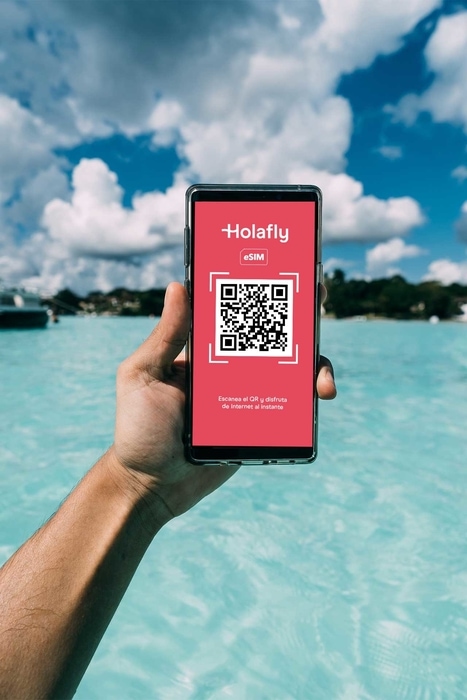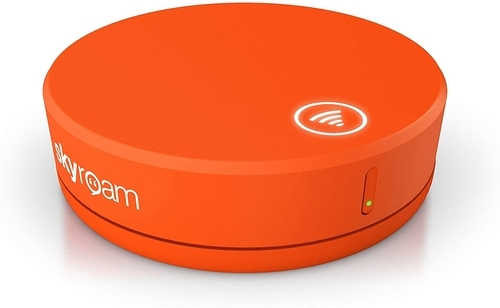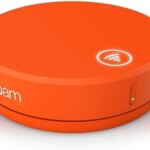Having Internet in Europe is something you’ll want to consider when planning your trip to this diverse continent. Not only will Wi-Fi in Europe help you look up directions and book reservations, but it’ll keep you connected to friends and family back home.
Until a few years ago, roaming in Europe was an expensive service, so if you used the Internet, made calls, or sent texts, you’d rack up a huge bill. However, a few years ago, the European Union passed a law that made data roaming in the EU free for travelers in European Union countries, Iceland, Liechtenstein, and Norway. So, if you’re from any of those countries, you can use your phone’s regular SIM card and enjoy Internet while traveling around Europe.

How to get Internet in Europe without roaming fees
For travelers from the US, the UK, Canada, and other countries, a SIM card for Europe will help you stay connected during your trip. I always use the Holafly eSIM, which is super easy to install since it’s 100% digital. It also provides coverage in over 32 destinations in Europe, as well as unlimited data and 60 minutes of calls made and received within Europe. If you’re interested, be sure to take advantage of our Holafly discount code.
As you can see, there are different ways to get Internet while traveling, so keep reading to see which option suits you.
Using roaming in Europe
Data roaming in Europe is a service that allows you to have mobile data for surfing the Web, making calls, and sending texts while abroad. This is possible because your telephone company has agreements with different local operators across Europe, so you can stay connected without changing your usual SIM card.
However, this service is super expensive, even if you travel to the cheapest destinations in Europe, so if you use it, you’ll come home to a big phone bill. It’s a much better idea to use an EU pocket Wi-Fi device, a European Wi-Fi hotspot, or a European SIM card. Each of these options will let you have Internet in the EU at a much cheaper price.
As I mentioned, the EU passed a law a few years ago that makes roaming in Europe free between its member countries as well as Iceland, Liechtenstein, and Norway. So, as long as you have a European SIM card, you can use your data throughout the continent, regardless of which country you bought it in, and without being charged extra fees.

Using roaming to get Internet in Europe
If you don’t have a SIM card for Europe and want to use data roaming in the EU, I’ll tell you how to do so, but get ready for a hefty phone bill. You should also keep in mind that some European countries aren’t part of this EU law, so if you want to have Internet in Switzerland, or stay connected in Andorra, for example, it’s worth looking for alternative methods.
To clear things up, here is a complete list of the countries included in the EU roaming agreement: Austria, Belgium, Bulgaria, Croatia, Cyprus, Czech Republic, Denmark, Estonia, Finland, France, Germany, Greece, Hungary, Iceland, Ireland, Italy, Latvia, Liechtenstein, Lithuania, Luxembourg, Malta, Netherlands, Norway, Poland, Portugal, Romania, Slovakia, Slovenia, Spain, and Sweden.
The United Kingdom isn’t included in this agreement, but some UK telecom companies don’t charge for roaming in Europe. However, if you’re coming from the U.S., you’ll need to find a solution so you can avoid high roaming charges.
Fortunately, there are several ways to get cheap mobile Internet in Europe, such as the Holafly eSIM for Europe. I’ll share more options below, so keep reading!
How to get Internet in Europe
If you’re coming from the United States, the UK, or any other country not included in the EU roaming agreement, your usual SIM card won’t cover data roaming in Europe. Don’t worry though because I’m sharing the best ways to get Internet in Europe.
1. Holafly eSIM, the best way to get Internet in Europe
First, the Holafly eSIM is the best way to get mobile Internet in Europe. It offers great coverage in over 32 countries, as well as unlimited data. Plus, since it’s totally digital, installation is super easy, and you can even purchase it when you’re already abroad.
To get this eSIM for Europe, you must order it through the Holafly website. Immediately after purchasing it, you’ll receive an email with a QR code that you need to scan to start browsing the Internet. If you have any issues, the Holafly customer service team is available 24 hours a day, so it’s the most convenient option.
This European Internet card is ideal for travelers who don’t have a dual SIM slot on their devices. Since the eSIM is 100% digital, you don’t need to insert it and worry about keeping your original SIM safe while traveling. You can also keep your local number, making this a practical solution for people who need the Internet in Europe for work. Holafly’s European mobile plans with unlimited data also offer 60 minutes to receive calls and 60 minutes to make calls in Europe.
Before buying the international eSIM card, make sure you check your device’s compatibility here. Holafly works with all the latest smartphone models, but it’s always a good idea to check anyway.
DAYS | GB | PRICE |
|---|---|---|
5 days | Unlimited | $19 |
7 days | Unlimited | $27 |
15 days | Unlimited | $34 |
20 days | Unlimited | $47 |
30 days | Unlimited | $64 |
60 days | Unlimited | $87 |
90 days | Unlimited | $99 |
We’ve used Holafly in over 10 different countries and have always had excellent coverage, so I highly recommend it if you want to have Internet in the EU. If you decide to get it, make sure you use our 5% discount on Holafly to save money.
2. SimOptions SIM card, another good way to get Internet in the EU
If the Holafly eSIM isn’t compatible with your device, or you prefer a physical card, I recommend the SimOptions SIM card. It offers several different plans at affordable prices, so you can get Wi-Fi in Europe without breaking the bank.
Installing this SIM is simple since you just have to insert it into your device. Of course, if you don’t have a dual SIM slot, you’ll have to remove your usual SIM and store it somewhere safe while you use the European one.
Another nice thing about SimOptions is that they can send the European mobile data SIM card to any part of Europe within 1-3 business days. This means you can have it sent to your hotel so it’s ready for you when you arrive. You can also order it before your trip and have it delivered to your house, but make sure you give yourself ample time since it’ll take up to 72 hours for it to arrive.
Depending on the card you choose, SimOptions can be more expensive than the Holafly eSIM. Also, Holafly offers unlimited Internet in Europe, so it’s my first choice.
DAYS | GB | PRICE |
|---|---|---|
14 days | 12 GB | $30 |
14 days | 30 GB | $50 |
30 days | 10 GB | $25 |
30 days | 30 GB | $45 |
3. Local SIM card, a cheap way to get Internet in Europe
For those who are on a budget, there are ways to get cheap mobile Internet in Europe. In this case, you can buy a local SIM card at your destination, as these cards are available in any country.
The downside is that you’ll have to spend time figuring out which option best suits your needs when you arrive at your destination. This involves comparing the different telephone companies and their prices and data plans depending on the first country on your tour.
To give you a head start, I’ll tell you that two of the most popular companies are Orange and Vodafone, which operate in many European countries. You can see an overview of their EU mobile Internet plans and prices below:
7 DAYS | 14 DAYS | 30 DAYS |
|
|---|---|---|---|
Orange SIM Card | 20 GB/$50 | 50 GB/$10 |
|
Vodafone SIM Card | 1 GB/$5 | 50 GB/$50 |
|
BEST SIM CARDS FOR EUROPE |
|||
In my opinion, buying a local European Internet card can be useful for long trips. However, if it’s a short visit, you don’t want to waste time shopping around and comparing the different offers.
4. Pocket Wi-Fi, another option for using the European Internet
Another practical way to get Internet and data in Europe is by using a portable Wi-Fi device. There are different European pocket Wi-Fi options, such as this mini router, which we use and love. If you work remotely like us, this is the most convenient way to enjoy mobile Wi-Fi in Europe while ensuring a secure, encrypted connection.
You can use EU pocket Wi-Fi even if your device is locked, and you won’t have to risk your information by using a public network. In addition to greater flexibility, having portable Wi-Fi in Europe allows you to connect several devices simultaneously. If you’re traveling as a group, this can work out great and save everyone money, compared to the other European Internet options. Otherwise, you should consider whether the benefits of a pocket Wi-Fi device outweigh their high mobile data plan prices.
5. Public Wi-Fi network, a way to get free Internet in the EU
The last option I’ll mention is using the public Wi-Fi network at hotels, restaurants, and airports during your trip. While you’ll be able to use the Internet in Europe for free, there are definite drawbacks.

Public Wi-Fi network, a way to get free Internet in the EU
For example, the connection isn’t reliable, and may not even be secure, so you’ll risk having your data stolen. Also, the Internet speeds in Europe via public Wi-Fi are much slower since many devices are connected. You may even have a time or data usage limit per day, which can be frustrating. And of course, you’ll only be able to access the Web if you’re in that specific spot, so it’s not ideal for traveling.
If you only need to check your email and messages, then using public Wi-Fi in the EU may suffice. However, for working and staying connected to friends or loved ones, I recommend choosing one of the other options I mentioned, such as an international SIM card or European Wi-Fi router.
How much is roaming in Europe?
If you’re from one of the countries in the EU data roaming agreement, then there is no cost for roaming in Europe. Just go into the Settings menu on your device and make sure Data Roaming is activated.

How much is Internet in Europe if you roam?
For everyone else, including travelers from the UK or U.S., roaming in the EU could be pretty expensive, so I don’t recommend it. Rather, I suggest going with one of the options I mentioned in this guide, such as a European SIM card or mobile hotspot for Europe.
What is the best way to have Internet in Europe?
Hands down, the best way to have Internet in Europe is by using a European SIM card. If you don’t have one because you’re visiting from outside Europe, then I recommend getting the Holafly eSIM, a virtual SIM card with unlimited data for Europe. If your device isn’t compatible with an eSIM, then a physical card from SimOptions is the best option.
I hope this guide helps you get the best travel Wi-Fi in Europe for your needs and budget. Don’t hesitate to leave me a comment with any questions you have about accessing the Internet in Europe.
Stay safe and have a great European adventure!





















